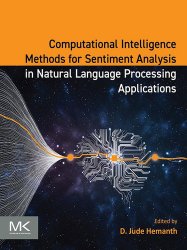Computational Intelligence Methods for Sentiment Analysis in Natural Language Processing Applications
- Добавил: literator
- Дата: 21-01-2024, 17:47
- Комментариев: 0
 Название: Computational Intelligence Methods for Sentiment Analysis in Natural Language Processing Applications
Название: Computational Intelligence Methods for Sentiment Analysis in Natural Language Processing ApplicationsАвтор: D. Jude Hemanth
Издательство: Morgan Kaufmann/Elsevier
Год: 2024
Страниц: 254
Язык: английский
Формат: epub
Размер: 11.2 MB
Computational Intelligence for Sentiment Analysis in Natural Language Processing Applications provides a solution to this problem through detailed technical coverage of AI-based Sentiment Analysis methods for various applications. The book's authors provide readers with an in-depth look at the challenges and associated solutions, including case studies and real-world scenarios from across the globe. Development of scientific and enterprise applications are covered that will aid computer scientists in building practical/real-world AI-based Sentiment Analysis systems. With the vast increase in Big Data, computational intelligence approaches have become a necessity for Natural Language Processing (NLP) and Sentiment Analysis in a wide range of decision-making application areas.
Includes basic concepts, technical explanations, and case studies for in-depth explanation of the Sentiment Analysis
Aids computer scientists in developing practical/real-world AI-based Sentiment Analysis systems
Provides readers with real-world development applications of AI-based Sentiment Analysis, including transfer learning for opinion mining from pandemic medical data, sarcasm detection using neural networks in human-computer interaction, and emotion detection using the random-forest algorithm
Social media analytics has become superimportant in today’s scenario with the rise in Internet technology. The impact of social media on day-to-day life is enormous with applications ranging from new connections formation to restaurant selection. Sentiment analysis is one of the application areas where a complete opinion on a specific entity is generated by Artificial Intelligence (AI) techniques. Sentiments which can be termed “opinions” may be positive or negative or neutral. The opinions are normally given in the form of text data which are a part of natural language processing (NLP). The opinions registered by the users on a specific subject is collectively analyzed to provide a final comment on the subject. Analyzing these data is a tedious task that can be solved by Machine Learning (ML) techniques. Hence, the combination of sentiments and ML techniques is extremely important to derive any information from the huge social media data. In this book, different types of ML and deep learning methods are explored in the context of different dimensions of sentiment analysis.
Chapter 1 provides an in-depth information on the basic concepts of ML and sentiment analysis. Different types of ML models are suitable for different sentiment analysis applications. These aspects are highlighted in this chapter along with the challenges and future scope of these methods. Deep learning is the advanced version of ML which is discussed in Chapter 2. The advantages of deep learning are explored in the context of aspect-based sentiment analysis. A complete package of text-based sentiment analysis is provided in Chapter 3. The merits and demerits of the different techniques are analyzed in detail. A different dimension of natural linguistic reasoning is discussed in Chapter 4. The concepts of rule-based systems in NLP are dealt in detail in this chapter.
Chapter 5 deals with the deep learning models for detecting the hate speeches in social media such as Twitter. Specifically, long-short-term memory methods are used in this work. Drug review classification from social data is the focal point of Chapter 6. Different NLP-based methodologies are used in this work to classify the input data. Chapter 7 discusses about the concepts of human behavior analysis. Emotion detection with text data is the main application area of this chapter. Different ML techniques are tested in this work and a detailed evaluation on these methods is provided in terms of the performance measures. Analyzing the opinions about movies is the base of the research works in Chapter 8. Different ML and optimization techniques are used in this work for the sentiment analysis. Since the rise of online platforms for movies, this type of analysis has gained high significance in the entertainment industry.
Customer feedback analysis on different products is discussed in Chapter 9. This type of sentiment analysis is very important for e-commerce-based applications. The ML methods concentrate on double negative sentence detection in this work. Sarcastic words/sentences are heavily used in all modes of communication, specifically in the social media. Deep learning–based methods are used to detect sarcasm in Chapter 10. Abusive comments are another unwanted concept in any language. The deep learning–based methods discussed in Chapter 11 are used to detect these comments in Tamil language. Stock market data-based sentiment analysis is elaborated in Chapter 12. Hateful and offensive contents on social media are detected using several AI-based approaches in Chapter 13.
Скачать Computational Intelligence Methods for Sentiment Analysis in Natural Language Processing Applications
Внимание
Уважаемый посетитель, Вы зашли на сайт как незарегистрированный пользователь.
Мы рекомендуем Вам зарегистрироваться либо войти на сайт под своим именем.
Уважаемый посетитель, Вы зашли на сайт как незарегистрированный пользователь.
Мы рекомендуем Вам зарегистрироваться либо войти на сайт под своим именем.
Информация
Посетители, находящиеся в группе Гости, не могут оставлять комментарии к данной публикации.
Посетители, находящиеся в группе Гости, не могут оставлять комментарии к данной публикации.
